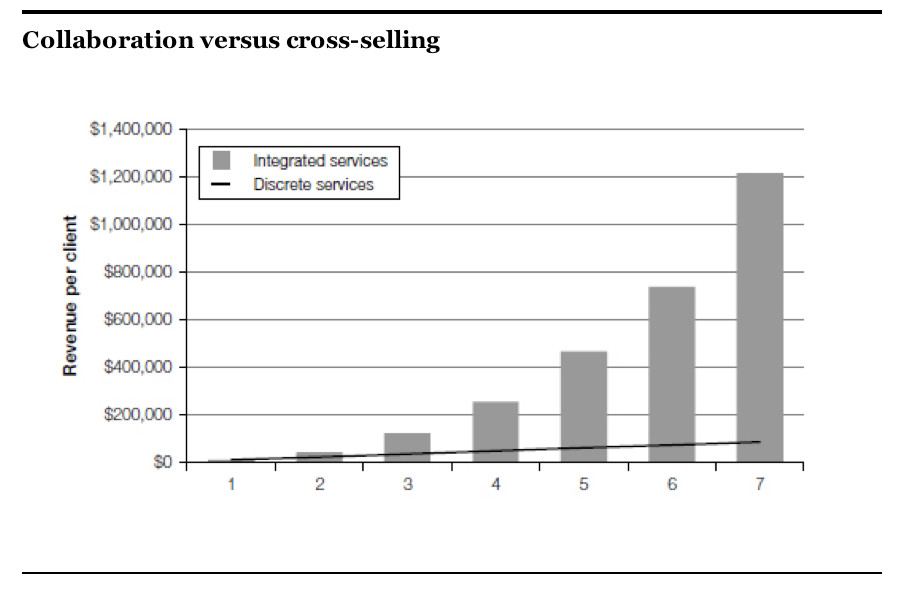7 key enablers of smart collaboration
In 7 key enablers of smart collaboration, Joel Barolsky takes another angle to the topical theme of collaboration in BigLaw firms, following from Pam Woldow’s post on Dialogue a couple of weeks ago. Joel’s post today sets out his views on execution and describes seven key enablers of smart collaboration…
In January 2017, Harvard professor and ex-McKinsey consultant, Heidi Gardner, published Smart Collaboration. The book describes the results of her 10-year study into the benefits of collaboration in professional service firms. Gardner concludes that firms that effectively integrate cross-team solutions to solve clients’ problems will significantly outperform those that just rely on cross-selling solo-specialists:
The book is great in making the case for collaboration but is a little thin when it comes to the “how to” bit. This post is my take on execution and describes seven key enablers of smart collaboration…
#1 The right clients
The business case for collaboration is much stronger when your firm is servicing [i] large client organisations, [ii] with complex and diverse needs, and [iii] relatively sophisticated approaches to purchasing professional services. For instance, a small monoline insurer with a cab-rank panel structure would not be a prime prospect.
#2 Capability breadth
Gardner states that the true benefits of smart collaboration come from combining the skills and experience of a range of different practitioners to solve the client’s most pressing problems. This multi-disciplinary approach is hard to copy, is less price sensitive and much more fun to deliver.
It follows, therefore, that firms need to have service depth AND breadth for collaboration to pay off. Larger full-service firms would have relatively more opportunity than others.
#3 A culture of “our” client, not “my”client
In many firms, the prevailing culture is one where client relationships are primarily owned by individual partners, rather than seen as assets of the firm. In these instances, distrust of colleagues to serve “their” clients is more common than not. Trying to facilitate smart collaboration in a deeply individualistic culture is a long and hard road.
Many of the professional service firms I work with think they are collaborative, but in reality, they’re collegiate. The latter describes a club of friends happy to socialise together. The former describes a one-firm firm where everyone is hardwired to win and deliver together.
#4 Great client leaders
Client Relationship Partners work across practice teams to bring the best of the firm to the client, and the whole of the client to the firm. These boundary-spanners are crucial in growing the network of relationships between the firm and the client. Success is more likely if the firm empowers this important leadership role, and invests in developing its client leader talent pool.
#5 Effective client knowledge sharing
Gardner states that a “collaborative technology platform” is essential in connecting partners with the right opportunities. While I broadly agree, many firms fail to get a positive return on their CRM investments, not because of technology issues, but because the cultural and strategic settings don’t facilitate communication and knowledge sharing.
Collaboration is enhanced by partners having a good understanding of [i] the firm’s full capability set, [ii] the client’s context and needs, and [iii] the details of the firm-client interaction.
#6 Consistency in energy and standards
The outcomes of a team are significantly enhanced when all team members have similar service standards. Problems arise if one team member thinks a “responsive” email reply is 24 hours, while another thinks its 24 minutes. It also helps if all team members have a similar drive to succeed and share common values around client focus.
There are two schools of thought around consistency of service style. Those who argue for a house-style cite benefits of a seamless client experience, resource fungibility and delivery efficiencies. The contrary view is that differences in style facilitate diversity and creativity. I’m more in the latter camp.
#7 The right measures and rewards
In the words of Peter Drucker, “what gets measured gets managed”. In the words of James Goldsmith, “if you pay peanuts, you get monkeys”. If the firm incentivises solo-specialist behaviours and outcomes, the chances of meaningful collaboration are exceedingly low.
Call to action
Gardner’s research clearly illustrates the benefits of smart collaboration over cross-selling. If you sense the potential in your firm: [i] write down each of these seven enablers; [ii] give your firm a score out of 10 on each, and [iii] identify the key actions to shift the dial in the next six months, and closer to a 10 over the next 36 months.
Author
 Joel Barolsky is Managing Director of Barolsky Advisors and Senior Fellow of The University of Melbourne. He has worked with over 100 of Australia and New Zealand’s top professional service firms as a strategy advisor and facilitator. Joel is the lead author of the 2015 and 2016 Thomson Reuters Peer Monitor Melbourne Law School State of the Legal Market Report. He was a Principal of Beaton Research + Consulting for many years. For further details go to http://www.barolskyadvisors.com
Joel Barolsky is Managing Director of Barolsky Advisors and Senior Fellow of The University of Melbourne. He has worked with over 100 of Australia and New Zealand’s top professional service firms as a strategy advisor and facilitator. Joel is the lead author of the 2015 and 2016 Thomson Reuters Peer Monitor Melbourne Law School State of the Legal Market Report. He was a Principal of Beaton Research + Consulting for many years. For further details go to http://www.barolskyadvisors.com
Joel’s post first appeared on Relationship Capital, 10 March 2017, and is re-purposed here with Joel’s kind permission.



Great summary of the enablers.
I found “Smart Collaboration” and Gardner’s approach refreshing because, based on relevant and reliable data, she builds a logical and compelling business case for collaboration in professional service firms. This is a more conventional basis to market collaboration to law firms and partners who struggle with it for all the usual reasons – if you are not convinced by any of the “soft” arguments then do it for the money !
It is interesting to consider what the follow statement means for the Big 4’s expansion in legal: “Gardner concludes that firms that effectively integrate cross-team solutions to solve clients’ problems will significantly outperform those that just rely on cross-selling solo-specialists”